
Rick Dangerous is a platform game developed by Core Design for the Acorn Archimedes, Amiga, Atari ST, Amstrad CPC, ZX Spectrum, Commodore 64, and MS-DOS. The game was released in 1989 and published by MicroProse on the Firebird Software label in the UK, and on the MicroPlay label in America. It was also published in Spain by Erbe Software. Later, it was released with two other games, Stunt Car Racer and MicroProse Soccer, on the Commodore 64 Powerplay 64 cartridge. The game was followed by a sequel, Rick Dangerous 2, in 1990. Loosely based on the Indiana Jones film franchise, the game received mixed reviews from critics.
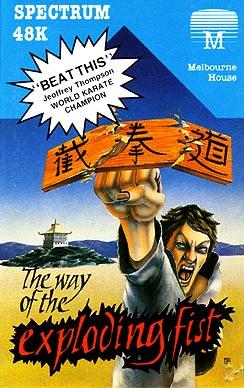
The Way of the Exploding Fist is a 1985 fighting game based on Japanese martial arts developed by Beam Software, by a team consisting of Gregg Barnett, Bruce Bayley, Neil Brennan and David Johnston. Originally developed on the Commodore 64 and published in May 1985 by Melbourne House, ports were made for Amstrad CPC, ZX Spectrum, BBC Micro, Acorn Electron and Commodore 16.

Sensible Soccer, often called Sensi, is an association football video game series which was popular in the early 1990s and which still retains a following. It was developed by Sensible Software and first released for Amiga and Atari ST computers in 1992 as well as for the IBM PC compatibles. The series was created by Jon Hare and Chris Yates, as a successor to their previous football game MicroProse Soccer (1988), which in turn was inspired by the arcade video game Tehkan World Cup (1985).

Sensible Software was a British software company founded by Jon Hare and Chris Yates that was active from March 1986 to June 1999. It released seven number-one hit games and won numerous industry awards.
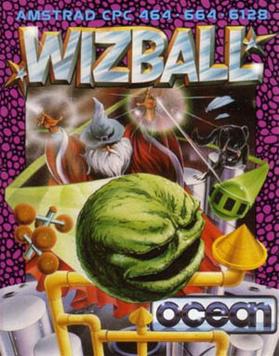
Wizball is a horizontally scrolling shooter written by Jon Hare and Chris Yates and released in 1987 for the Commodore 64 and later in the year for the ZX Spectrum and Amstrad CPC. Versions for the Amiga and Atari ST were released in the following year. Wizball was also ported to IBM PC compatibles and the Thomson MO5.

Stunt Car Racer is a racing video game developed by Geoff Crammond. It was published in 1989 by MicroProse, under their MicroStyle and MicroPlay labels in the United Kingdom and in the United States, respectively. The game pits two racers on an elevated track on which they race in a head-to-head competition, with ramps they must correctly drive off as the main obstacle.
Ocean Software Ltd was a British software development company that became one of the biggest European video game developers and publishers of the 1980s and 1990s.

Emlyn Hughes International Soccer (EHIS) is a soccer computer game first released in 1988 by Audiogenic Software Ltd. The game is named after the popular English footballer Emlyn Hughes. It initially appeared on the Commodore 64, with other versions produced for the Amstrad CPC, ZX Spectrum, Atari ST and Amiga.

The Commodore 64 Games System is the cartridge-based home video game console version of the popular Commodore 64 home computer. It was released in December 1990 by Commodore into a booming console market dominated by Nintendo and Sega. It was only released in Europe and was a considerable commercial failure. The C64GS came bundled with a cartridge containing four games: Fiendish Freddy's Big Top O'Fun, International Soccer, Flimbo's Quest, and Klax.
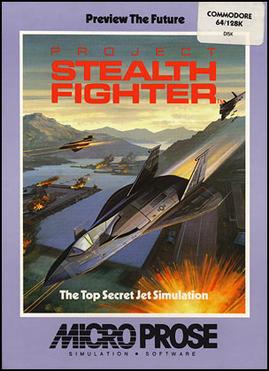
Project Stealth Fighter is a combat flight simulator released for the Commodore 64 in 1987 by MicroProse, featuring a fictional United States military aircraft. During the time of the game's release, there was heavy speculation surrounding a missing aircraft in the United States Air Force's numbering system, the F-19. Project Stealth Fighter was later renamed F-19 Stealth Fighter and was remade in 1988 for the 16-bit systems with much improved graphics.

Carrier Command is a 1988 video game published by Rainbird for the Amiga, Atari ST, IBM PC compatibles, ZX Spectrum, Macintosh, Commodore 64, and Amstrad CPC. Carrier Command is a cross between a vehicle simulation game and a real-time strategy game where players control a robotic aircraft carrier.

Tynesoft Computer Software was a software developer and publisher in the 1980s and early 1990s.
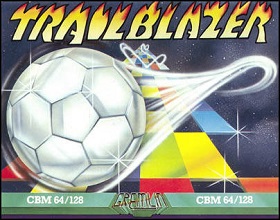
Trailblazer is a racing video game developed by Mr. Chip Software and published by Gremlin Graphics for the ZX Spectrum, Commodore 64, Atari 8-bit computers, Amstrad CPC, Commodore 16 and Plus/4 in 1986. It was ported to the Amiga and Atari ST.

Jon "Jops" Hare is an English computer game designer, video game artist, musician and one of many founder members of the early UK games industry as co-founder and director, along with Chris Yates, of Sensible Software, one of the most successful European games development companies of the late 1980s and 1990s.

Spindizzy is an isometric video game released for several 8-bit home computers in 1986 by Electric Dreams Software. It combines action and puzzle video game elements. Players must navigate a series of screens to explore a landscape suspended in a three-dimensional space. Development was headed by Paul Shirley, who drew inspiration from Ultimate Play the Game games that feature an isometric projection.
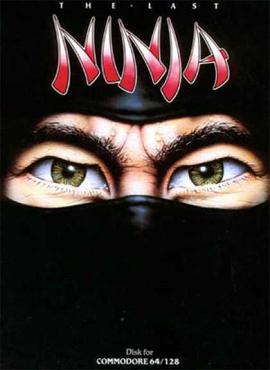
The Last Ninja is an action-adventure game originally developed and published by System 3 in 1987 for the Commodore 64. It was converted to the Apple IIGS, MS-DOS, BBC Micro and Acorn Electron in 1988, the Apple II series in 1989, the Amiga and Atari ST in 1990, and the Acorn Archimedes in 1991.
Barry Leitch is a Scottish video game music composer. MHis work includes the Lotus Turbo Challenge, TFX, Gauntlet Legends, Gauntlet Dark Legacy, Top Gear, and Rush video game series.

Sensible World of Soccer is a 1994 football video game designed and developed by Sensible Software as the sequel to their 1992 game Sensible Soccer. It combines a 2D football game with a comprehensive manager mode. The game includes contemporary season data of professional football from around the world, with a total number of 1,500 teams and 27,000 players.

Tehkan World Cup, originally released as World Cup in Japan, is an association football video game released to arcades in 1985 by Tehkan, the former name of Tecmo. It features multiplayer gameplay and trackball controllers. It was released in both upright and table arcade cabinets, but was most commonly released in a cocktail cabinet form factor. Its arrival coincided with the buildup to the 1986 FIFA World Cup. It featured the then colors of several of the world's top teams such as West Germany, Argentina and Brazil, although it did not mention any team by name.

Parallax is a shoot 'em up video game developed by British company Sensible Software for the Commodore 64. It was released in 1986 by Ocean Software in Europe and Mindscape in North America. The game was named after its primary graphical feature, parallax scrolling, which gives the illusion of depth to side-scrolling video games. On release, reviews praised the game's mix of traditional side-scrolling action and adventure game-inspired puzzles.


















